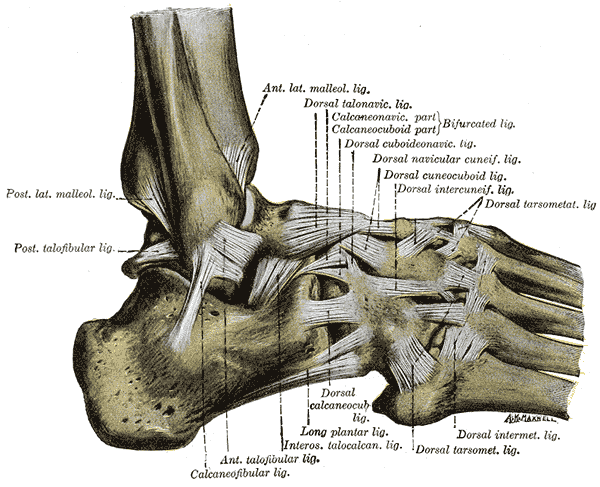The myth of weak ankles
Ankle sprains are the most common sports injury seen at the emergency department or doctors clinic. They account for 25% of all sports injuries and are particularly common in indoor or court sports such as basketball, volleyball or squash. 85% of all ankle sprains involve the lateral (outside) ligaments. The usual mechanism of injury includes rolling the ankle into plantar flexion (toe down) and inversion. Depending on the extent of damage the ankle sprain is graded from 1 – 3.

A grade-1 ankle sprain involves stretching of only the anterior talofibular ligament (runs from the lateral ankle bone to the top of the foot [talus]). There is tenderness in one specific point, very little swelling and no effect on walking.
A grade-2 ankle sprain involves partial tearing of both the anterior talofibular ligament and the calcaneofibular ligament (runs from the heel bone [calcaneus] to the lateral ankle bone]. The tenderness is over the specific ligament and more wide spread, there is moderate swelling and pain on walking, possibly resulting in the need for crutches.
A grade-3 ankle sprain is a complete tear of at least two of the three branches of the lateral collateral ligaments of the ankle. In addition there may be more extensive damage such as fracture of the 5th metatarsal or damage to the ligaments between the tibia and fibula. With a grade-3 ankle sprain there is severe swelling and bruising, laxity in the ligaments and inability to walk.
There are 3 stages to healing of a sprained ankle with different treatment options during each.
The acute stage is when the ankle is swollen, perhaps bruised and very painful. You may not be able to bear any weight on the leg and the ankle feels hot. This usually lasts between 3-5 days. RICE (Rest, Ice, Compression, Elevation) is well known for the management in the acute phase. This helps reduce the inflammation and pain. Physiotherapy can assist by providing the correct ankle brace or taping to protect the joint, and loan of crutches if necessary. To promote tissue healing low level ultrasound or laser can be used and gentle soft tissue massage helps the swelling. Exercises are aimed at achieving pain free passive range of motion and manual therapy techniques can address any positional faults.
In the next stage the tissues start to repair. The inflammation reduces and the pain settles. This is a really critical phase and return to sport at this point is particularly dangerous. Depending on the extent of the injury it can take from 3 days to 6 weeks. In mild or moderate sprains this is when a lot re-injuries happen: there is hardly any pain and we are tempted to go out and play sports again. But the ankle still needs protection and movements should be controlled, as strength and balance have not yet returned to pre-injury levels. The physiotherapist will advise on which brace or taping to use during this stage. Ultrasound, laser and soft tissue massage will promote healing. Exercises are progressed to achieve pain free full active range of motion in all directions. The balance in the ankle will be affected and this needs careful re-training. Balance boards, BOSU and static strength exercises are used.
The final stage is maturation when the area of healing becomes stronger and the body is ready to slowly be conditioned back to playing sport. This can take from 3 weeks to over 1 year. To avoid long-term consequences and increased risk of recurrent ankle sprains your rehabilitation MUST go on. Prevention of re-injury is essential – taping or bracing is used particularly during training. Careful reconditioning will enable a faster and safer return to sport. Special exercises called plyometrics are used to provide the speed of recovery and control that is required. These include burpees, box jumps and squat jumps. Balance can be improved using wobble boards, trampolines and exercises standing on one leg. Functional exercises, such as jumping, running and changing directions need to be perfected prior to returning to sport.
In a mild ankle sprain the initial injury may seem to resolve quite quickly. However, it is shown that without rehabilitation you are 2x more likely to sprain your ankle again within 1 year of the initial injury. Prior to returning to sport it is essential that the ankle is completely pain free, that all swelling has resolved, that full range of movement and full strength are achieved and sufficient balance, agility and co-ordination have returned.